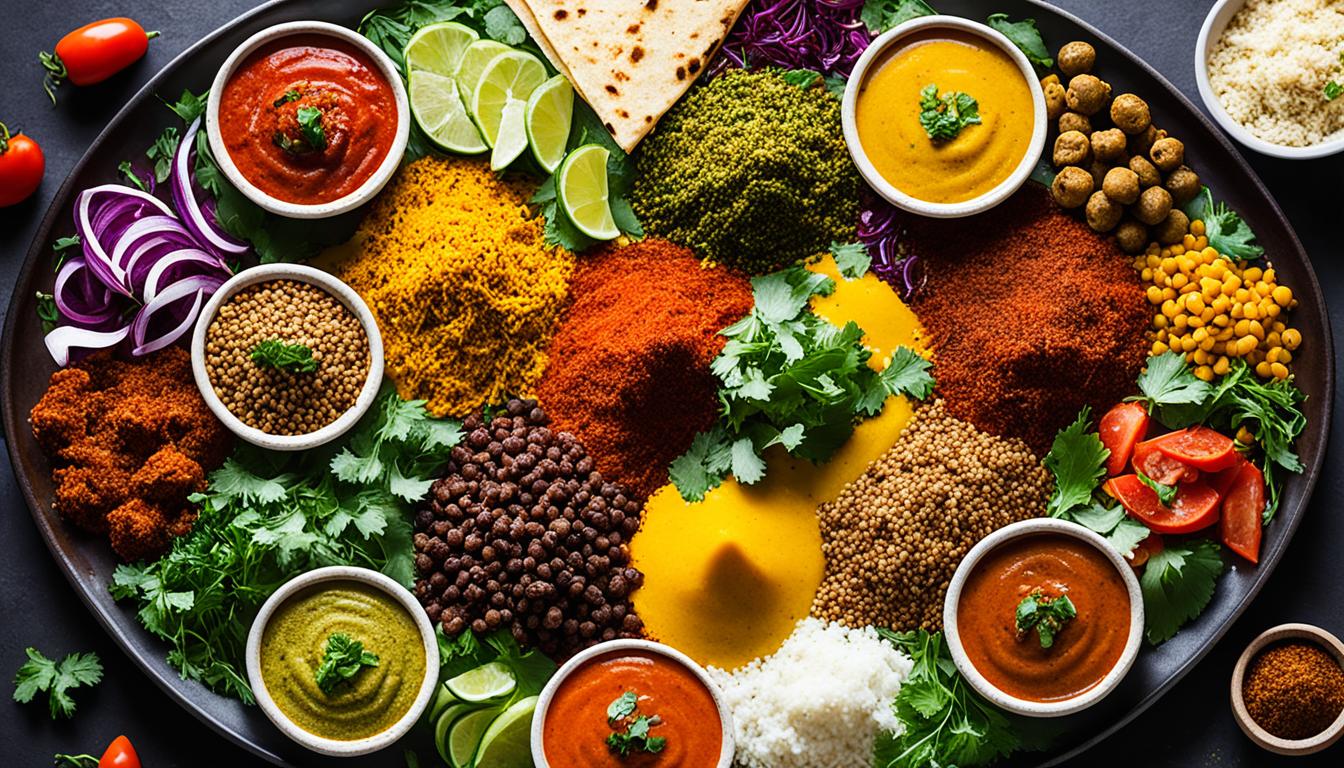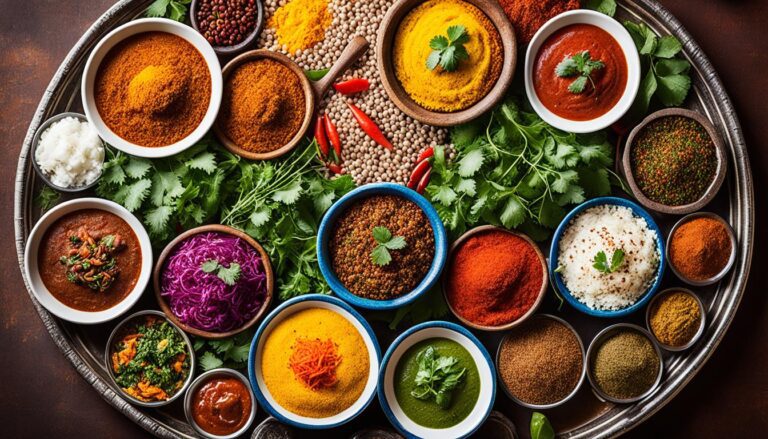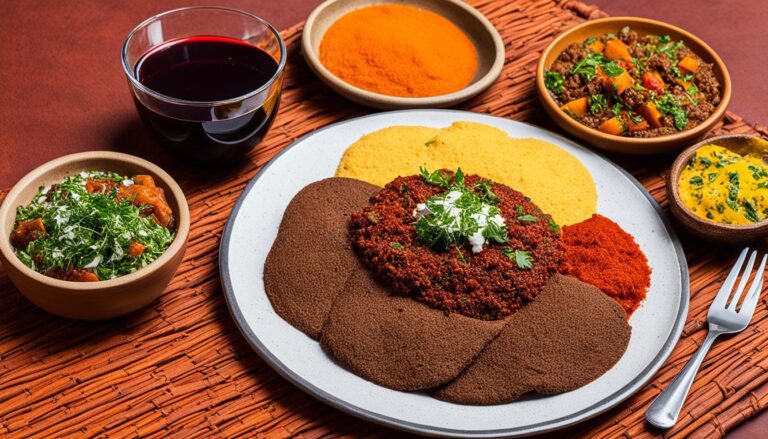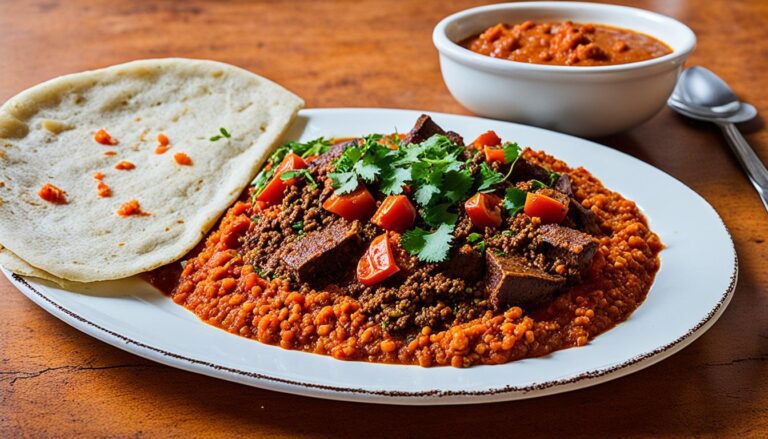Is Ethiopian Food Dairy Free?
Welcome to our exploration of Ethiopian cuisine and its dairy-free nature. If you’re someone who follows a dairy-free diet or has any dietary restrictions related to dairy, you might be wondering if Ethiopian food is a suitable choice for you. Join us on this culinary journey as we uncover the secrets of Ethiopian dishes and discover the dairy-free options it has to offer.
Key Takeaways:
- Ethiopian cuisine is known for its rich and diverse flavors.
- Traditional Ethiopian dishes form the backbone of the cuisine.
- There are a variety of dairy-free options in Ethiopian food.
- Dairy alternatives can be used to recreate authentic Ethiopian flavors.
- Understanding the cultural context enhances our appreciation of dairy-free choices in Ethiopian dishes.
Ethiopian Cuisine: A Culinary Delight
Before we dive into the dairy-free aspect, let’s take a moment to appreciate the rich and diverse flavors of Ethiopian cuisine. Known for its unique blend of spices and herbs, Ethiopian food is a delight to the taste buds.
With a history spanning centuries, Ethiopian cuisine is a treasure trove of culinary traditions. From the fragrant aroma of freshly roasted coffee to the savory bite of injera, every dish tells a story of cultural heritage and regional flavors.
One of the defining characteristics of Ethiopian cuisine is the use of spices. From fiery berbere to the earthy flavors of mitmita, these spice blends entice the senses and add depth to each dish. The result is a symphony of flavors that is both bold and intricate.
An essential component of Ethiopian cuisine is injera, a spongy and tangy sourdough flatbread made from fermented teff flour. It serves as the foundation for many Ethiopian meals and is often used as a utensil to scoop up stews and dishes.
The traditional way of eating Ethiopian food is communal, with friends and family gathering around a large platter to share a variety of dishes. This creates a sense of togetherness and fosters a warm and inviting atmosphere.
From hearty meat stews like doro wat and kitfo to flavorful vegetarian dishes like misir wot and gomen, Ethiopian cuisine offers a wide range of options for every palate. The bold flavors, vibrant colors, and diverse textures make each bite an adventure.
Whether you’re a fan of spicy food or prefer milder flavors, Ethiopian cuisine has something to offer. So, join us as we explore the dairy-free wonders of this culinary tradition and discover the incredible flavors that await!
Understanding Traditional Ethiopian Dishes
To understand the dairy-free nature of Ethiopian food, it’s essential to familiarize ourselves with the traditional dishes that form the backbone of Ethiopian cuisine. From injera, a sourdough flatbread, to doro wat, a spicy chicken stew, we’ll explore these dishes and their ingredients.
One iconic Ethiopian dish is injera, a staple food that serves as both a utensil and a flavorful accompaniment to various dishes. Made from fermented teff flour, injera is tangy, slightly sour, and has a unique spongy texture. It pairs perfectly with a variety of traditional Ethiopian stews, such as doro wat, a spicy chicken stew made with berbere spice blend.
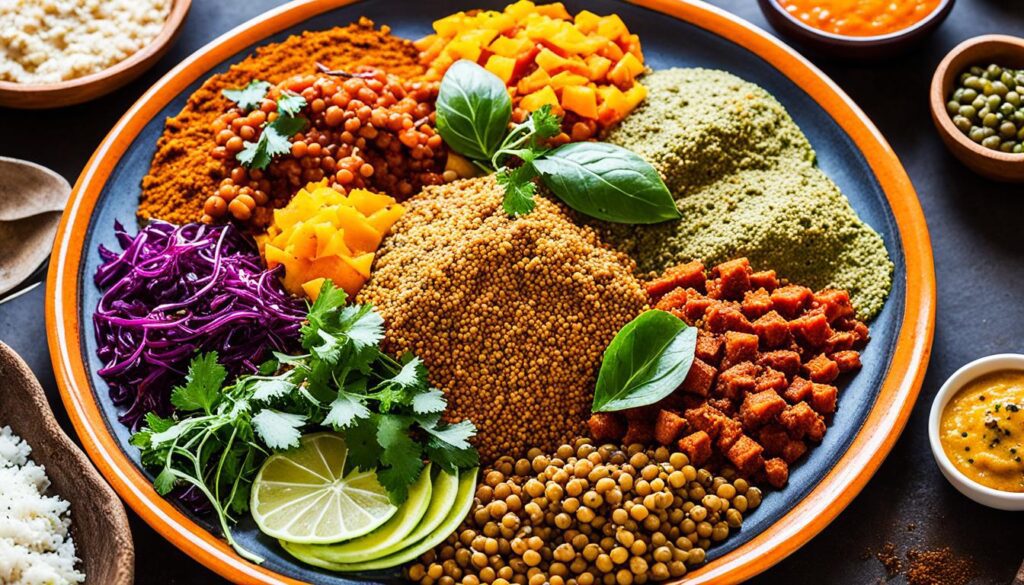
Delving into the rich flavors of Ethiopian cuisine
Another popular dish is kitfo, a minced meat dish traditionally made from raw beef, seasoned with spices and served with injera. However, for those who prefer cooked meat, it can also be prepared by sautéing the beef before serving.
Ethiopian cuisine is known for its vegetarian-friendly options as well. Lentils play a significant role in Ethiopian dishes, particularly in dishes like misir wat, a spicy red lentil stew, and kik alicha, a mild yellow split pea stew. These dishes showcase the versatility and rich flavors that can be achieved without the need for dairy products.
One cannot discuss traditional Ethiopian dishes without mentioning the variety of vegetable dishes that are an integral part of Ethiopian cuisine. From gomen, a collard greens dish, to fasolia, a green bean stew, Ethiopian vegetable dishes provide a burst of freshness and vibrant flavors.
Exploring Ethiopian Ingredients
In Ethiopian cooking, a rich variety of ingredients come together to create the vibrant flavors the cuisine is known for. Let’s take a closer look at the key ingredients that are commonly used in Ethiopian dishes, while highlighting the ones that are dairy-free.
One of the essential components of Ethiopian cuisine is the berbere spice blend. This aromatic blend typically includes chili peppers, garlic, ginger, coriander, and other flavorful spices. Berbere adds a distinct heat and complexity to many Ethiopian dishes.
Lentils also play a prominent role in Ethiopian cooking. These protein-packed legumes come in various colors and sizes, including red, green, and brown. Lentils are often cooked with spices and herbs to create hearty and flavorful stews.
Vegetables are another vital part of Ethiopian ingredients. From vibrant greens like collard greens and kale to versatile root vegetables like potatoes and carrots, Ethiopian cuisine incorporates a wide range of produce. These vegetables are often used in dishes such as tikel gomen (spiced cabbage and carrots) and yatakilt alicha (spiced mixed vegetables).
To enhance the flavors of Ethiopian dishes, a variety of herbs and spices are used, such as nigella seeds, thyme, cumin, and cinnamon. These aromatic ingredients infuse the cuisine with layers of complexity and depth.
When exploring Ethiopian cuisine, you will find an abundance of dairy-free ingredients that form the foundation of the dishes. These flavorful ingredients allow individuals following a dairy-free diet to enjoy the rich and diverse flavors of Ethiopian food while maintaining their dietary preferences.
Dairy-Free Options in Ethiopian Food
For those following a dairy-free diet, you’ll be glad to know that Ethiopian food offers a variety of options that are free from any dairy products. Let’s explore some delicious dairy-free dishes that you can enjoy while experiencing the flavors of Ethiopia.
Shiro
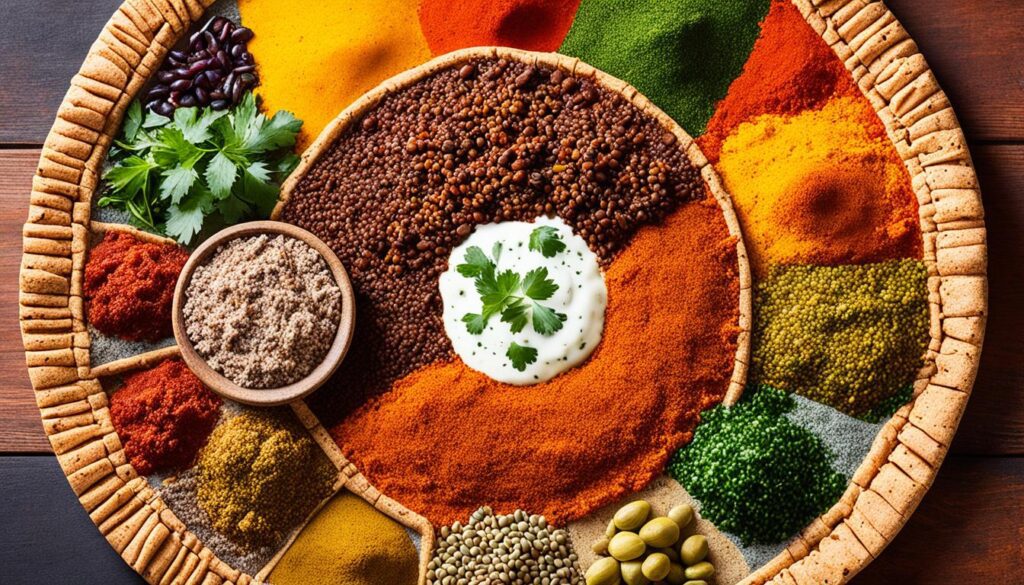
Tikel Gomen
Another delicious dairy-free dish is tikel gomen, a spiced cabbage and carrot dish. Made with sautéed cabbage, carrots, onions, garlic, and various spices, tikel gomen offers a burst of flavors that will leave you wanting more. This dish is often enjoyed as a side dish or as part of a larger Ethiopian feast, complementing the other flavors on the plate.
With these dairy-free options, you can savor the unique and vibrant flavors of Ethiopian cuisine without any worries about dairy ingredients. Whether you’re a fan of shiro or tikel gomen, these dishes will surely satisfy your taste buds and make your dining experience authentic and enjoyable.
Embracing Dairy Alternatives for Ethiopian Recipes
If you’re looking to recreate authentic Ethiopian flavors while maintaining a dairy-free diet, we’ve got you covered. In this section, we’ll explore alternative ingredients and cooking techniques that can be used to replace dairy products in Ethiopian recipes, ensuring a delicious and dairy-free experience.
One key aspect of Ethiopian cuisine is the abundant use of spices and herbs, which contribute to its unique and vibrant flavors. These flavors can be enhanced by using dairy alternatives such as plant-based milk or yogurt substitutes. By substituting dairy milk with almond milk, coconut milk, or soy milk in recipes that call for milk, you can preserve the richness and creaminess without the dairy content.
Another dairy alternative commonly used in Ethiopian cooking is plant-based yogurt. Made from ingredients like almonds, coconuts, or soy, these yogurts can provide the tanginess and texture that traditional dairy yogurt offers. They work well in recipes like Ethiopian cottage cheese and can be enjoyed as a topping or dip alongside injera, the staple Ethiopian flatbread.
When it comes to thickening sauces or stews, dairy alternatives like cashew or almond cream can be used instead of heavy cream or butter. These alternatives provide a creamy texture and add depth to the flavors without the use of dairy. Simply blend soaked cashews or almonds with water until smooth, and incorporate the mixture into your recipes as needed.
In addition to dairy alternatives, Ethiopian cuisine offers a wide variety of naturally dairy-free ingredients that can be used to create flavorful dishes. Lentils, chickpeas, and a variety of vegetables like potatoes, carrots, and greens are commonly used as the base for stews, soups, and curries. These plant-based ingredients provide protein, fiber, and a range of essential nutrients, making them an excellent choice for dairy-free meals.
Furthermore, Ethiopian cuisine incorporates a generous amount of spices and aromatics. These include berbere, a zesty spice blend made from chili peppers, paprika, ginger, and other flavorful ingredients. Utilizing these spices contributes to the complexity and depth of the dishes, allowing you to savor the vibrant flavors without relying on dairy products.
Ethiopian Food Culture and Allergen Awareness
As we delve into the world of Ethiopian cuisine and its dairy-free options, it’s important to understand the cultural context and practices surrounding Ethiopian food. Ethiopian food culture is deeply rooted in communal dining and sharing meals with loved ones. It is a celebration of flavors, traditions, and togetherness.
In Ethiopian food culture, allergen awareness, including dairy, plays a significant role. Ethiopian cuisine traditionally avoids the use of dairy products, making it a suitable choice for individuals with lactose intolerance or those following a dairy-free diet. This is particularly beneficial for those seeking diverse and flavorful culinary experiences while ensuring their dietary needs are met.
The image above beautifully captures the essence of Ethiopian food culture, showcasing a spread of vibrant and aromatic dishes that are emblematic of this rich culinary heritage. It serves as a visual reminder of the diverse flavors and ingredients that make Ethiopian cuisine so unique.
By embracing the dairy-free aspect of Ethiopian food, we not only cater to dietary preferences and requirements but also gain a deeper appreciation for the cultural significance and practices associated with this cuisine. The inclusive nature of Ethiopian food culture ensures that everyone can come together and enjoy a delicious meal, regardless of their dietary restrictions or preferences.
Now that we have explored the cultural elements and allergen awareness within Ethiopian cuisine, let’s continue our journey of discovering the delightful and dairy-free options that Ethiopian food has to offer.
Conclusion
After exploring the rich diversity of Ethiopian cuisine and its dairy-free options, we can confidently say that Ethiopian food can indeed be enjoyed while adhering to a dairy-free diet. Whether you’re a fan of injera, spicy stews, or flavorful legume dishes, Ethiopian cuisine offers an abundance of dairy-free choices that will satisfy your taste buds. So go ahead, explore the flavors of Ethiopia and indulge in a dairy-free culinary adventure.

